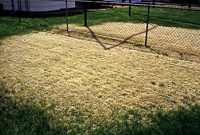Zoysiagrass
is a fantastic grass...but NOT FOR NORTHERN LAWNS! Every year,
many people get attracted to this wonder grass through
advertisements on the back page of the Sunday supplement. It
is touted as a grass that will fill in quickly and squeeze out
all those
weeds and be as durable as a cement pad.
 Many
of these claims are more or less true. The problem is that
Zoysiagrass is a warm season grass. In the northern part of
the country, we grow cool season grasses such as
Kentucky bluegrass,
perennial ryegrass and the
fescues. These species grow and
expand during the cool of the spring and fall. They want to go
dormant in the heat of the summer unless they are watered
regularly.
Many
of these claims are more or less true. The problem is that
Zoysiagrass is a warm season grass. In the northern part of
the country, we grow cool season grasses such as
Kentucky bluegrass,
perennial ryegrass and the
fescues. These species grow and
expand during the cool of the spring and fall. They want to go
dormant in the heat of the summer unless they are watered
regularly.
 Warm season grasses like Zoysiagrass only
grow during hot weather. The rest of the year, they turn a
bright straw-brown color and stay dormant. In the north, this
means that Zoysiagrass lawns don’t turn green until near the
end of May and they go dormant again as soon as temperatures
cool down in early September. Most people want their lawns to
be green from about early April to late November.
Warm season grasses like Zoysiagrass only
grow during hot weather. The rest of the year, they turn a
bright straw-brown color and stay dormant. In the north, this
means that Zoysiagrass lawns don’t turn green until near the
end of May and they go dormant again as soon as temperatures
cool down in early September. Most people want their lawns to
be green from about early April to late November.
The other problem with Zoysiagrass is,
ironically, the result of one of its strengths. Sure, it
spreads and fill an area with a thick mat. Unfortunately, it
does not recognize property boundaries and will often spread
into your neighbor’s yard too. That can strain otherwise
friendly relations.
To get rid of Zoysiagrass, you must kill it
all with an
herbicide such as
glyphosate (Roundup, Kleenup,
etc.). As an alternative, you could try to smother it by
covering the entire area with black plastic or by piling
leaves on it for several weeks. Once you are sure it is all
dead, reseed the area with a mixture of bluegrass, perennial
ryegrass and
fescue.
Remember that the old saying that, "If it
sounds too good to be true, it probably is." applies to
horticulture too.



